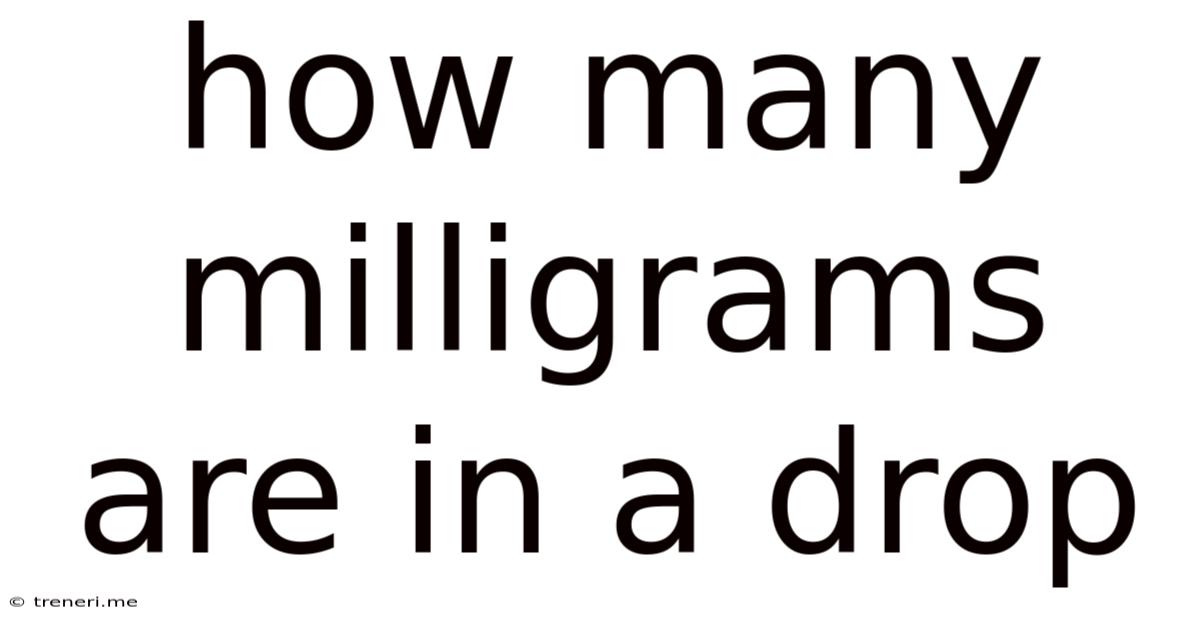How Many Milligrams Are In A Drop
Treneri
May 12, 2025 · 4 min read

Table of Contents
How Many Milligrams are in a Drop? A Comprehensive Guide
The question, "How many milligrams are in a drop?" doesn't have a simple answer. It's a deceptively complex query that depends on several crucial factors. Understanding these factors is key to accurately calculating dosages and ensuring safety, particularly in medicine and scientific applications. This comprehensive guide will delve into the intricacies of this question, exploring the variables involved and providing a framework for making more accurate estimations.
The Variables Affecting Milligrams per Drop
The number of milligrams in a drop is not a fixed value. It's highly variable and depends on these key factors:
1. The Density of the Substance
Density, measured as mass per unit volume (typically g/mL or kg/L), is paramount. A denser substance will have more mass in the same volume compared to a less dense substance. For example, a drop of mercury (very dense) will contain significantly more mass (and therefore more milligrams) than a drop of water (less dense).
Example: A drop of water might weigh approximately 50 mg, while a drop of mercury, due to its much higher density, might weigh several hundred milligrams.
2. The Viscosity of the Substance
Viscosity refers to a liquid's resistance to flow. High-viscosity liquids, like honey or syrup, tend to form larger drops than low-viscosity liquids like water or alcohol. A larger drop naturally contains more mass and, consequently, more milligrams.
Example: A drop of honey will be considerably larger and heavier than a drop of water, resulting in a higher milligram count per drop.
3. The Dropper or Dispensing Method
The type of dropper or dispensing device significantly impacts drop size. Different droppers have different orifices (openings), leading to variations in drop volume. Even with the same dropper, variations in the angle of dispensing or the force applied can affect the size of each drop.
Example: A standard eye dropper will produce drops of a different size than a pipette, leading to substantial differences in the milligram content per drop.
4. The Temperature of the Substance
Temperature can influence a liquid's density and viscosity. Changes in temperature can alter the volume of a drop, thereby changing the mass (and milligrams) contained within. This effect is typically more pronounced for liquids that exhibit significant thermal expansion.
Example: A drop of water at 4°C (its maximum density) will have a slightly different mass than a drop of water at room temperature.
5. Surface Tension
Surface tension, the tendency of liquid surfaces to shrink into the minimum surface area possible, plays a role in drop formation. Liquids with higher surface tension tend to form smaller, more uniform drops. This contrasts with liquids with lower surface tension, which may produce larger, less uniform drops.
Example: A drop of a liquid with high surface tension, like mercury, will generally be smaller and contain fewer milligrams than a drop of a liquid with low surface tension, like water.
The Challenges of Accurate Conversion
Given the numerous factors influencing drop size, it's impossible to provide a universally applicable conversion factor from drops to milligrams. There's no single magic number. Attempting to do so without considering the above variables could lead to inaccurate dosages and potentially dangerous consequences, particularly in medical settings.
Practical Considerations and Alternatives
Instead of relying on a "drops to milligrams" conversion, it is far safer and more accurate to use alternative measurement methods:
-
Weighing: If precision is crucial (e.g., in laboratory settings or when administering potent medications), using a precise balance to measure the mass (in milligrams) directly is the most accurate method.
-
Volume Measurement: Employing calibrated instruments such as graduated cylinders, pipettes, or syringes offers a much more reliable way to determine the volume of a liquid, which, combined with the substance's known density, allows for precise mass calculation.
-
Pre-measured Doses: Many liquid medications come pre-measured, either in unit doses or with clear markings on the container. Always follow the manufacturer's instructions for accurate dosage.
Understanding the Context: Medical Implications
In a medical context, relying on drops for dosage is generally discouraged, especially for potent medications. The inconsistencies inherent in drop size can lead to significant errors in dosage, potentially causing adverse reactions or ineffective treatment. Always follow a doctor's instructions and use the prescribed measurement tools.
Conclusion: Precision over Estimation
The seemingly simple question of "how many milligrams are in a drop?" highlights the importance of precise measurement in various fields, particularly in medicine and science. While a rough estimate might be acceptable in some non-critical situations, relying on drop size for accurate dosage is strongly discouraged. The variables involved introduce too much uncertainty. Always prioritize using calibrated measuring instruments and adhering to proper procedures for accurate and safe handling of liquids and dosage administration. The health and safety implications of inaccurate measurements cannot be overstated. Using alternative and precise measurement methods should always be the preferred approach.
Latest Posts
Latest Posts
-
How To Measure A Room In Square Meters
May 12, 2025
-
Cuantas Son 16 Onzas En Litros
May 12, 2025
-
Calculating Heat Loss In A House
May 12, 2025
-
How Many Zeptoseconds Are In A Year
May 12, 2025
-
How Old Is Someone Born November 2005
May 12, 2025
Related Post
Thank you for visiting our website which covers about How Many Milligrams Are In A Drop . We hope the information provided has been useful to you. Feel free to contact us if you have any questions or need further assistance. See you next time and don't miss to bookmark.